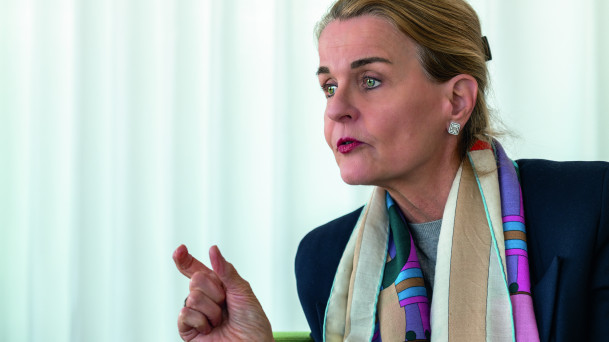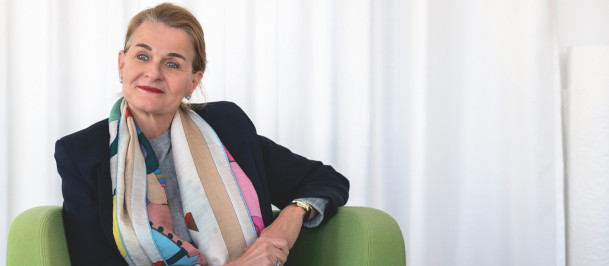Geschenke zum Jubiläum
The beginning of Leica’s anniversary year was marked by a splendid opening. In our interview, Karin Rehn-Kaufmann reveals what is particularly dear to her heart and what else is to come in this year.
In-between Dubai and New York, we meet Karin Rehn-Kaufmann in Wetzlar. In her capacity as Art Director and Chief Representative, she holds management responsibility for 28 Leica Galleries around the world, thus spending a lot of time on the road. But it quickly becomes clear: For her, this is much more than just a job.
W3+: In 1914, Oskar Barnack designed the first small format camera, the so-called Ur-Leica. In 1925, the first camera that was ready to go into series production, the Leica I, was launched. Is it possible to determine which date was the more important?
Karin Rehn-Kaufmann: 1914 marks the moment when Oskar Barnack’s idea for a completely novel camera became reality. The same year, as is well known, saw the beginning of the First World War which would not end before November 1918. The economy of the following years was characterized by severe inflation. Having the courage to bring this camera to the series production stage and launch it on the market in such a time is no lesser feat than its invention. In 1925, the Leica I was presented to the public at the Leipzig Spring Fair. I would say that this was the actual initial impetus that sparked an unrivaled success story.
W3+: The Leica I did not only revolutionize photography from a technical point of view but it did so to the act of taking photographs as such. It is said that from this time on, the Leica has acted as “Witness to a Century” and even shaped the collective visual memory over generations. Would you agree?
Karin Rehn-Kaufmann: On all accounts. But on closer examination, what the Leica has accomplished as “Witness to a Century” is quite complex: For one thing, there are the excellent technology and stellar optics of the cameras that have made so much possible in photography which just couldn’t be done previously. Some often iconic pictures taken during the past 100 years give evidence of that. But it also takes the people behind the cameras whose photos have actually shaped the view of the world over generations, as you say. These are all facets we want to reflect in our centenary.
W3+: It has not always been the case at Leica that history and tradition were invoked to such an extent, has it?
Karin Rehn-Kaufmann: I think that there has always been an awareness of them – only the attention they received was sometimes more, sometimes less acute in the course of the company’s history. You see, the origin of all that, of all we are doing and celebrating here is plainly and simply: a photographic camera, albeit a very special one. It signifies an innovational strength that has made us big over many product generations in the past 100 years. Our entrepreneurial responsibility lies in equal measure with how we look at these innovations and with what kind of innovative products we are going to develop today and in the future. This is the thought behind everything we do.

»What I am looking forward to in particular are the many anniversary events in Wetzlar. Here is where our history is rooted, this is where our future lies.«
Karin Rehn-Kaufmann
W3+: From your point of view, how important is it to not only recount Leica’s history of technology and their products but also to cultivate the associated cultural history of the photographic picture?
Karin Rehn-Kaufmann: From the very beginning, it has been a matter of a great importance to my husband, Andreas Kaufmann, and me to give the unparalleled history of our products and the associated culture of photography a platform. When we took up the reins in 2004, there were four Leica Galleries in New York and Tokyo, in Frankfurt and Solms. In 2008, I opened the Leica Gallery in Salzburg. After that, everything went quickly. This year, we will open the twenty-eighth Leica Gallery. What is more, in addition to the Leica Hall of Fame Award, we also lend more radiance to the Leica Oskar Barnack Award for contemporary photography. And the Ernst Leitz Museum in Wetzlar is simply a great place to provide a platform for photographers of international renown but also for young talents, as in the exhibition of our finalists and winners of the LOBA. I really enjoy this every time I’m here.
W3+: The first two anniversary exhibitions in Wetzlar – “Street Magic” and “The Good Picture” – were fitted exclusively with photos from the Leica archive.
Karin Rehn-Kaufmann: That’s right, and it makes me a little bit proud, too. For the largely unseen work done in the archive is a real gift. Again and again, new and surprising treasures are discovered in there. That’s what we deliberately wanted to share with the public. The “Street Photography” exhibition is about the various different encounters between people on the street in front of and behind the camera. Every picture and every photographer tell their own unique story. In the exhibition “The Good Picture”, we provide an insight into the archive which may be less prominent but all the more exciting. Originally, these “proofs of performance” mounted on index cards were intended as a demonstration of the results that could be achieved with Leica cameras and lenses. But among them are incredibly awesome photos which give just as much evidence about the creative “performance” of the photographers.
W3+: “100 Years of Leica I” will be celebrated all over the globe: from Dubai to Milan, from New York to Shanghai, even a whole week long in Wetzlar during the last week in June. What are you looking forward to the most?
Karin Rehn-Kaufmann: Phew! I am unable to list all the things we have planned in the anniversary year. In fact, we have prepared an extensive program all around the world to celebrate 100 Years of Leica I together with our international community. What I am looking forward to in particular are the many anniversary events in Wetzlar. Here is where our history is rooted, this is where our future lies. At the end of June, there will indeed be a whole week of festivities in Wetzlar, opening with a concert of the youth orchestra Bella Fortuna from Salzburg and the Leica choir in the Wetzlar cathedral. Leica World will host an epic exhibition with works by Joel Meyerowitz. In cooperation with Galerie am Dom, the gallery next to the cathedral, we will present four magnificent female photographers, namely Herlinde Koelbl, Vera Mercer, Henrike Stahl, and Donata Wenders. In the New Town Hall, we will display the history of the production but also remarkable advertising materials and posters. There will be a ceremonial gala act in the Buderus Arena for invited guests – plus a family day for our employees. They are and have always been the most valuable part of the Leica community. And that’s what we want to celebrate extensively with them.
www.leicawelt.com
Karin Rehn-Kaufmann
In 2008, Karin Rehn-Kaufmann opened the first Leica Galerie in Salzburg. Today, she holds management responsibility for 28 Leica Galeries worldwide as Art Director & Chief Representative Leica Galleries International. She has curated numerous prestigious photographic exhibitions in Germany and abroad and is also responsible for the Ernst Leitz Museum in Wetzlar. Furthermore, Karin Rehn-Kaufmann is a member of the jury assigning the Leica Oskar Barnack Awards and has played a significant role in the organization and further development of this prestigious photographic competition.
